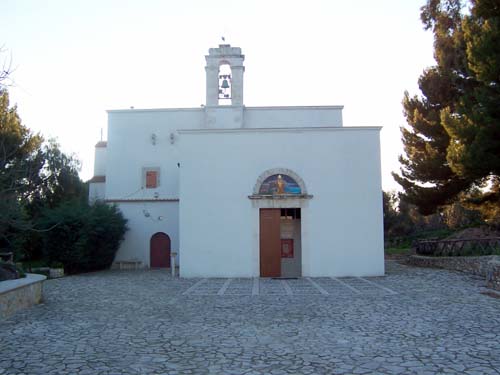SANCTUARY OF SANTA MARIA OF MERINO
SANCTUARY OF SANTA MARIA
The Sanctuary of Santa Maria of Merino is located about 8 kilometres north of Vieste, in the homonymous plain.
Of the ancient Villa only some fences are today visible.
Instead you can visit a small white cave church of Puglia like the farmhouses that were once built.
Every 9 May, since ancient times, the statue of the Madonna is carried in solemn procession from the Cathedral to this sanctuary.
It has enormous symbolic value for the people of Vieste.
According to a tradition, the church was built in a nearby place, where a wooden statue of the Virgin Mary was found. The central part of the sanctuary is the oldest (XI-XII century) and it is part of residue walls of an original Roman villa.
The church is surrounded by archaeological remains.
The slight bell gable with a bell dated 1851 is clearly visible in the front part. Moving to the right side you have a better view of the skylight, a little jewel that adorns the top of the dome of the presbytery.
You can further note how as a whole it is formed by four bodies added to each other subsequently.
The first chapel was built in devotion of Mister Petrone Pasquale Farina.
Continuing you find the second chapel, the date or reason of the building are unknown, but it is assumed, by careful studies, that it can be a constituent part of the wall of the Roman villa on which perhaps the first nucleus of the sanctuary was built.
Then there are the third and fourth chapels dedicated to the Virgin for devotion of the people of Vieste (1831) by the master Antonio M. Masanotti (1861).
The sanctuary from June to September hosts many tourists who want to participate in the Holy Mass.
Outside the sanctuary there is a beautiful Way of the Cross, a statue of Our Lady of Medjugorje.
In 2011 the sanctuary was enriched with a Holy Door that allows the indulgence and so the absolution of sins, according to the Scriptures.
The Holy Door is a work of the artist Michele Circiello and consists of a central top panel 'Christ the Redeemer of man', and of other six panels that tell in part the story of Pietro del Morrone. (This is the Pope Celestine V, who gave up the papacy humbly and sought peace over the Adriatic. He was a guest for a few days in the Sanctuary of Santa Maria of Merino and he was taken prisoner in Vieste).
Statue of Madonna of Merino
According to tradition, the statue is a fine wooden sculpture carved and painted of Byzantine origin (XIV century) and it was found by the farmers of Vieste and Peschici near Scialmarino beach, (a golden sandy beach, almost 3 km long).
Each of the two groups claimed it for themselves; an old sage advised them to place the statue on a cart pulled by oxen, and depending on the direction taken by the wagon, the statue would be placed in that place. So they did it, and the oxen walked in the direction of Vieste. From that day, Santa Maria of Merino is considered the protector of the people of Vieste.








